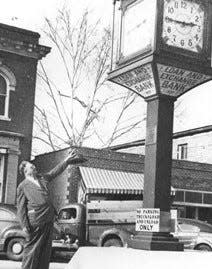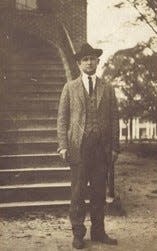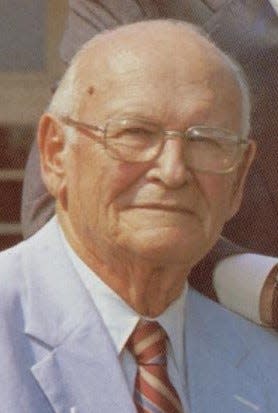Murdaugh dynasty includes history of taking on bankers and federal prosecutors

The ongoing federal trial of former Hampton banker Russell Lucius Laffitte is eerily similar and reminiscent of other major cases connected to the Murdaugh legal dynasty in the South Carolina Lowcountry over the past century.
Laffitte is standing trial in U.S. District Court in Charleston on a five-count federal indictment charging him with aiding disbarred attorney Richard "Alex" Murdaugh with stealing or misusing money from multiple personal-injury clients over several years.
Laffitte's family is a financial bedrock of Hampton County, and traces its roots back more than a hundred years as the founders of Palmetto State Bank.
Murdaugh's ancestors launched a one-man law firm in Hampton in 1910 that grew to become a personal-injury giant while controlling criminal law in the 14th Judicial Circuit by serving as solicitors for roughly 86 years.
During that century, Murdaugh's ancestors have been involved on both sides of the justice system. There've been in federal conspiracy cases and numerous criminal cases involving unscrupulous bankers in the compelling but controversial legal dynasty that serves as a powerful backstory for current events.
Murdaugh, the disgraced attorney, is also accused of murdering his wife and son in a case that has made international headlines and primetime true-crime documentaries.
Randolph Murdaugh Sr. took on corrupt bankers during Great Depression
Laffitte is accused of using his status and access as CEO of Palmetto State Bank to conspire with Murdaugh and take advantage of his legal clients.
These current allegations might have been looked upon with great displeasure by Murdaugh's great-grandfather, Randolph Murdaugh Sr., a former 14th Judicial Circuit prosecutor who spent much of his career prosecuting unscrupulous bankers during the bank collapses of the Great Depression.

The Laffitte family traces the origins of Palmetto State Bank back to the Loan and Exchange Bank of Hampton, which was established on Lee Avenue in Hampton in 1907 but later purchased by the Laffittes in 1955.
According to interviews conducted by the author for the University of South Carolina – Salkehatchie's "Salkehatchie Stew" history project, that bank's founder and president, R.O. Bowden, was well known for making unusual loans, which sometimes included loans for moonshining equipment, and for hiding money from federal regulators by burying it in the stables of his livestock business, the Horses and Asses Farm.
His was one of the few banks in Hampton County to survive the Great Depression.
As banker Bowden made a reputation for himself during that era, his contemporary, Randolph Sr., Alex Murdaugh's great-grandfather, made a name for himself in taking on bankers and banks.

Randolph Murdaugh Sr. took on cases involving officers of three of the largest banking institutions of that era in his hometown Hampton County — banks that he, his family and his associates likely did business with.
On Sept. 21, 1926, the Hampton County Grand Jury asked the solicitor to hand down indictments on officers of the Merchants and Planters Bank of Varnville, the Merchants and Planters Bank of Brunson, and the Bank of Hampton for violations of the state’s banking laws.
In February of 1928, Randolph Sr., working along with Hampton attorney George Warren, later a state senator, earned convictions on two Beaufort County bankers for making false statements in a conspiracy scandal involving the former Beaufort Bank. The convictions were appealed to the state Supreme Court but were upheld.
Taking on bad bankers would even pull the Hampton attorney out of his power zone in the 14th Circuit. In July of 1930, Randolph was appointed by state Attorney General John M. Daniel to represent South Carolina’s interests during a special term of court in Lancaster, 149 miles away. He prosecuted the case against two officers the First National Bank and Trust, a defunct organization at that time that had also been accused of violating state banking laws.
Power, prestige and privilege:Power, prestige and privilege: Inside the rise and fall of the Murdaugh dynasty in South Carolina
Murders, mystery, money: Murders, mystery, money: Here's a timeline of the Murdaugh family killings
Murdaugh was also involved in two major cases with state-level implications — one in defense of a South Carolina governor and one in prosecution of a former governor.
During Allendale County General Sessions Court the week of July 11, 1924, he prosecuted a major case against former Gov. Wilson G. Harvey, also the former president of the Enterprise Bank of Charleston, who was charged with violating state banking laws by accepting deposits even though he knew the failing bank was insolvent. The case pitted Murdaugh against another South Carolina legal legend, Edgar A. Brown, of Barnwell, who would later become a state senator and part of a powerful group of politicians known as “The Barnwell Ring.”
During the trial, Solicitor Murdaugh called five key witnesses and produced numerous banking documents. Over the strong objections of the defense, Murdaugh placed the former governor in the prisoner’s dock while the indictment was being read, a subtle move that changed how he was viewed, literally, and could've added insult to indictment. It was also an early example of the type of colorful, and often controversial, courtroom antics that his son and grandson would later become well known for, and often sanctioned for by the South Carolina Supreme Court.
Set in Allendale, just 30 minutes away from both Murdaugh’s stronghold of Hampton and Brown’s powerbase in Barnwell, the well-publicized trial resulted in an acquittal of Harvey. The defense called no witnesses and made a closing argument that the prosecution had failed to produce enough evidence to convict its client.
During a later trial in Allendale, in April of 1925, Murdaugh was able to earn a guilty plea from Harvey on charges of lending money to a corporation in which he had interests more than the amount allowed by law. The former governor pleaded guilty to lending excessive amounts of the Enterprise bank’s money to the Consolidated Truck and Auto Company of Charleston. In accepting Harvey’s guilty plea, Solicitor Murdaugh agreed to drop two other charges that included Harvey allegedly giving excessive loans to himself, and to his brother-in-law.
HBO Max, CNN specials:CNN and HBO Max to air TV specials exploring Murdaugh murders and alleged crimes
Not a "special defendant": SC says Alex Murdaugh should not be a 'special defendant'
Banker's trial has strong similarity to federal moonshine conspiracy case
Laffitte's federal trial has some interesting parallels with a federal case that happened decades ago and also involved members of the Murdaugh family, including Alex Murdaugh's grandfather, Randolph "Buster" Murdaugh Jr. Both conspiracy cases are set in federal courthouses in Charleston, an hour and a half away from the rural, small town of Hampton where the Laffittes and the Murdaughs are among the most prominent and wealthy families around.
Known as “The Great Colleton County Whiskey Conspiracy,” Buster's affair was a federal case “born in violence on a cold November morning,” The State newspaper wrote in 1951. That’s when federal agent Henderson Clary shot a bootlegger named Doc Freeman and feds later learned of allegations that the wounded moonshiner was “in cahoots” with local legal officials — and he didn’t take too kindly to being shot.
On June 5, 1956, after a five-year investigation, Murdaugh was among 30 defendants who were originally indicted by the federal government for conspiracy to violate the Internal Revenue laws relating to liquor.
Also indicted was Colleton County Sheriff G. Haskell Thompson, who pleaded not guilty and refused to turn in his badge.
Just like Laffitte’s attorneys filed pretrial motions seeking to have the charges dismissed, which were denied, in August of 1956, Murdaugh’s defense attorneys, Henry H. Edens and Henry Hammer, filed several motions seeking to have the charges dismissed on grounds of alleged improper grand jury evidence, and alleging that prosecutors were promising “light sentences” to the other defendants to encourage testimony against Murdaugh.
The motions also requested that Murdaugh be tried separately from the other defendants, claiming that in a joint trial the solicitor could be found guilty “by transference” rather than by evidence. In the motions, Murdaugh’s defense team added that, as solicitor, Murdaugh had prosecuted many of the coconspirators and, if tried along with them, his “substantial rights to a fair trial will be prejudiced.”
On Aug. 20, following a pre-trial conference, federal Judge Walter E. Hoffman denied Murdaugh’s motions, and the trial was scheduled for Sept. 17 in federal district court in Charleston.
.Just as Laffitte asserted his innocence during a pretrial interview that was released on YouTube the week before his trial, Murdaugh also pleaded his case in advance of the legal proceedings of his era.
“The security, honor and happiness of my wife and children face destruction, my personal integrity and liberty are at stake,” Murdaugh wrote in a letter to state officials. “With the help of Almighty God the falsity of the charges will be bared and I will return to the office of Solicitor.”
"Level playing field":Murdaugh team seeks ‘level playing field’ as Russell Laffitte is struck with new charges
What we know and don't:What we know, and don't know, about the Alex Murdaugh crime saga
Judges ask jurors to avoid exposure to media
Just as Laffitte’s attorneys plan to use audio recordings of bank board meetings in their defense, according to federal court documents, Buster Murdaugh’s prosecutors introduced a tape recording as evidence that was purported to be a conversation between Oscar Phillips, a local bootlegger, and Sheriff Thompson that was made Sept. 22, 1955, in the trunk of a car in which the men were sitting.
After the defense complained about newspaper coverage of the moonshine conspiracy trail, Judge Hoffman urged the jurors to avoid reading any news reports over the weekend.
The Laffitte trial, too, has became a high-profile case with a lot of media attention, causing the judge to order jurors to avoid media exposure.
Just as Laffitte’s legal team, Bart Daniel and Matt Austin, are currently battling it out with federal prosecutor Emily Limehouse, the 1956 case was equally heated as the two sides sparred.
Murdaugh took the stand and his questioning was described by the press as “a battle of wits and tempers” between the accused solicitor and Irvine Belser Jr., assistant U.S. attorney, a “parry and thrust” game which became heated at times. At one point, the judge warned both of them and threatened Belser with contempt of court if the questioning again moved out of the agreed-upon “bounds.”
During the final arguments of the 1956 trial, the assistant district attorney described the indicted former public officials, including Murdaugh, as “a bunch of buzzards and vultures.”
Murdaugh defense attorney Claud N. Sapp then called the government’s witnesses “a bunch of perjurers, thieves and convicts.”
The jury’s verdict came on Oct. 1. Murdaugh, along with two other defendants, was acquitted of all charges, though other public officials were convicted.
Sheriff Thompson earned the heaviest sentence: seven years in prison and a $3,000 fine. The deputies and magistrate received three years each, and the remaining defendants got two years or less.
In the final day of the session, as he was hearing pleas for leniency for the convicted, Judge Hoffman had a few strong words for the acquitted, including Murdaugh. He described Murdaugh’s conduct as “grossly unethical,” including the fact that he represented accused bootleggers in other federal proceedings.
“I can’t get involved in Colleton County politics, but I notice by the newspapers that Mr. Murdaugh plans to go back into office as solicitor,” Judge Hoffman said in court. “He is an acquitted man, and that is his prerogative. However, his unethical conduct — so grossly unethical by his own admission — was such that I couldn’t go back and face my people if I were he. But that’s his business and the business of the people there.”
A November 1956 U.S. Department of Justice memo added further condemnation for Murdaugh:
“The defense resorted to some highly questionable tactics, all apparently designed to bring about an acquittal or mistrial as to Solicitor Murdaugh even at the risk of sacrificing the remaining defendants….”
What will be the outcome of Laffitte's federal trial? That remains to be seen, but the case is expected to conclude by Nov. 18, setting the stage for the courtroom battles of Alex Murdaugh, which are expected to kick off in January 2023.
Michael DeWitt Jr. is the author of the upcoming "Fall of the House of Murdaugh: The Rise and Fall of a South Carolina Legal Dynasty;" and "Wicked Hampton County", scheduled for publication in the spring/summer of 2023.
This article originally appeared on Greenville News: Hampton history: Murdaugh dynasty took on bankers and prosecutors
